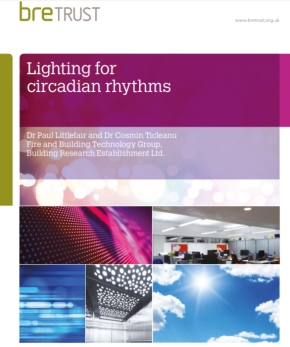Lighting for circadian rhythms
Lighting for circadian rhythms was written by Dr Paul Littlefair and Dr Cosmin Ticleanu and was published by the BRE Trust in October 2019.
People have circadian rhythms linked to the natural light/dark cycle of the day. These control patterns of alertness and sleep as well as other factors such as body temperature and the release of various hormones. Light and dark patterns act as the most important signal to entrain (synchronise) the circadian clock to the solar cycle and cause waking and sleeping to occur at consistent times.
A combination of bright light during the day and darkness at night helps maintain the daily cycle of waking and sleep. However, exposure to artificial light at the wrong times of day can have an adverse effect on circadian rhythms. Light at night time can alter the body clock, suppressing melatonin production and keeping people awake at night, and making them more sleepy during the day.
Circadian lighting varies in colour and intensity during the day. The aim is to improve alertness during working hours using bright light, but to switch to lower brightness, warmer coloured light before it is time to relax.
This report presents the results of an experiment to assess circadian lighting and provides guidance for building owners and occupiers, lighting designers, lighting manufacturers and installers.
Its contents are:
- Abstract.
- Introduction.
- Colour of light.
- Dynamic lighting: previous studies.
- Existing recommendations.
- An experiment to assess variable lighting.
- Results.
- Discussion.
- Conclusions and recommendations.
- Acknowledgements.
- References.
[edit] Related articles on Designing Buildings
- 7 ways better lighting can improve your health.
- BRE articles.
- BRE Expert Collection 6 Daylight and shading.
- BRE Trust.
- BREEAM External lighting.
- BREEAM Internal and external lighting.
- BREEAM Reduction of night time light pollution.
- BREEAM Visual comfort Daylighting.
- Building Research Establishment.
- CIBSE Case Study Hepworth Gallery Lighting.
- Circadian rhythms.
- Colour Rendering Index CRI.
- Daylight benefits in healthcare buildings.
- Health and wellbeing impacts of natural and artificial lighting.
- Human-centric lighting.
- Lighting and health FB 74.
- Lighting and health infographic.
- Lighting.
- Light Pollution - Human Health Impacts from LEDs.
- Types of lighting.
- Use of lighting to improve health and wellbeing.
Featured articles and news
Infrastructure that connect the physical and digital domains.
Harnessing robotics and AI in challenging environments
The key to nuclear decommissioning and fusion engineering.
BSRIA announces Lisa Ashworth as new CEO
Tasked with furthering BSRIA’s impressive growth ambitions.
Public buildings get half a million energy efficiency boost
£557 million to switch to cleaner heating and save on energy.
CIOB launches pre-election manifesto
Outlining potential future policies for the next government.
Grenfell Tower Inquiry announcement
Phase 2 hearings come to a close and the final report due in September.
Progress from Parts L, F and O: A whitepaper, one year on.
A replicated study to understand the opinion of practitioners.
ECA announces new president 2024
Electrical engineer and business leader Stuart Smith.
A distinct type of countryside that should be celebrated.
Should Part O be extended to existing buildings?
EAC brands heatwave adaptation a missed opportunity.
Definition of Statutory in workplace and facilities management
Established by IWFM, BESA, CIBSE and BSRIA.
Tackling the transition from traditional heating systems
59% lack the necessary information and confidence to switch.
The general election and the construction industry
As PM, Rishi Sunak announces July 4 date for an election.
Eco apprenticeships continue help grow green workforce
A year after being recognised at the King's coronation.
Permitted development rights for agricultural buildings
The changes coming into effect as of May 21, 2024.























